Background: Google Share Crash
- History:
- 18, Oct., 2012: Google posts a weak earnings report on its 3rd quarter;
- 19, Oct., 2012: Wall Street declines;
- 20, Oct., 2012: Google shares reduced by 10.5%;
- 21, Oct., 2012: Dow Jones falls to 13,549 (0.06%/8 points) (Singh, 2012).
- Aftermath:
- Microsoft stock closes down at 3.2%;
- Advanced Micro Devices, Inc. announces cutting its workforce by 15%;
- Weekly jobless claims peaked at 388,000;
- Shares declined in Asia.
- Google shares are down to $687.30, per share (Google loses $26 billion due to premature report, 2012).
Google share crash came unexpected in 2012 and put a number of companies in peril. Caused by a premature publishing of the company’s annual report, the crisis resulted in Google shares cost dropping rapidly and a range of companies being left nearly devastated. However, some of the companies miraculously managed to stay afloat and even use the situation to their advantage.

Motorola Company Model: Analysis
In man ways, Motorola’s success is explained by Google’s investments.
- 2011: Google offers Motorola Mobility Deal;
- 2011: Motorola merges with Google;
- Google spends $349 million for Motorola reconstruction (Blackman, 2013);
- Android is successfully launched into the market;
- Commercials are especially efficient;
- Number of clicks per advertisement is increased;
- Click volume increases by 42% (Womack, 2012).
Motorola is the first company that did not suffer much from the Google flop, mostly because the latter had invested into the firm by the time that the crisis occurred. Merging with the Google, Inc. in 2011, Motorola used Google’s investments wisely in order to introduce its new product into the global market.
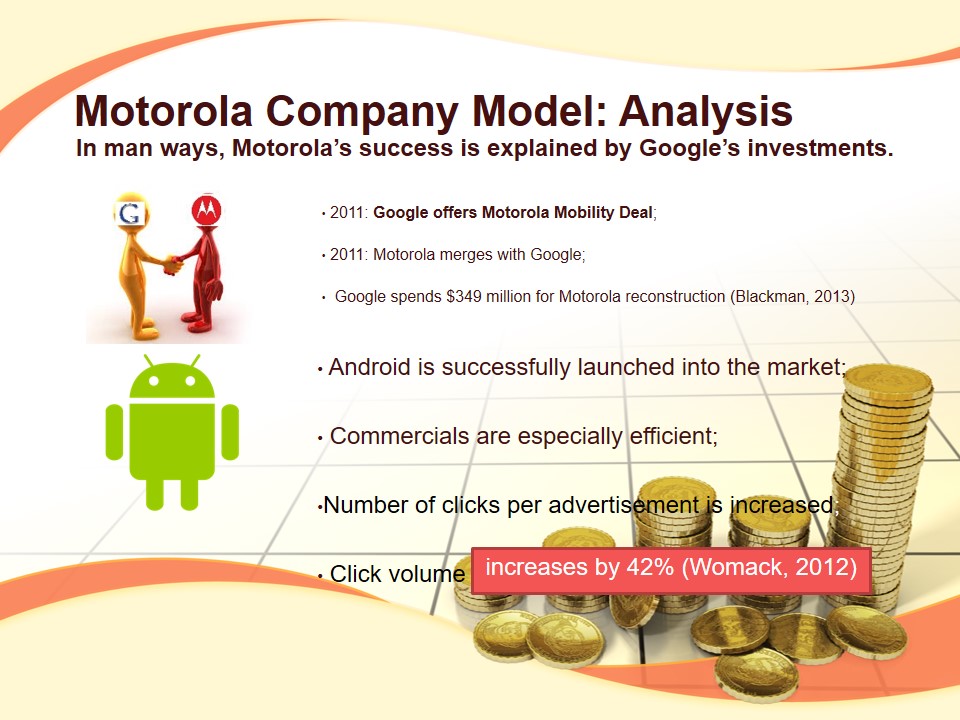
LG Company Model: Analysis
LG has survived the crisis owing to its remarkably original product.
- 2012: LG launches smartphone;
- New LG tablet is announced (by Google);
- Targeting upscale regional retailers (Berger, 2012);
- Distributing products in K-Marts, Wal-Marts, Sam’s Clubs, etc.
Likewise, the crisis did not have a tangible effect on the LG productivity and sales. While the company did experience the need to boost its performance, it managed to succeed due to the introduction of smartphones into the world market. The choice of K-arts and Wal-Marts as the place for selling the devices worked perfectly (Shan, Nazir & Zaman, 2013).
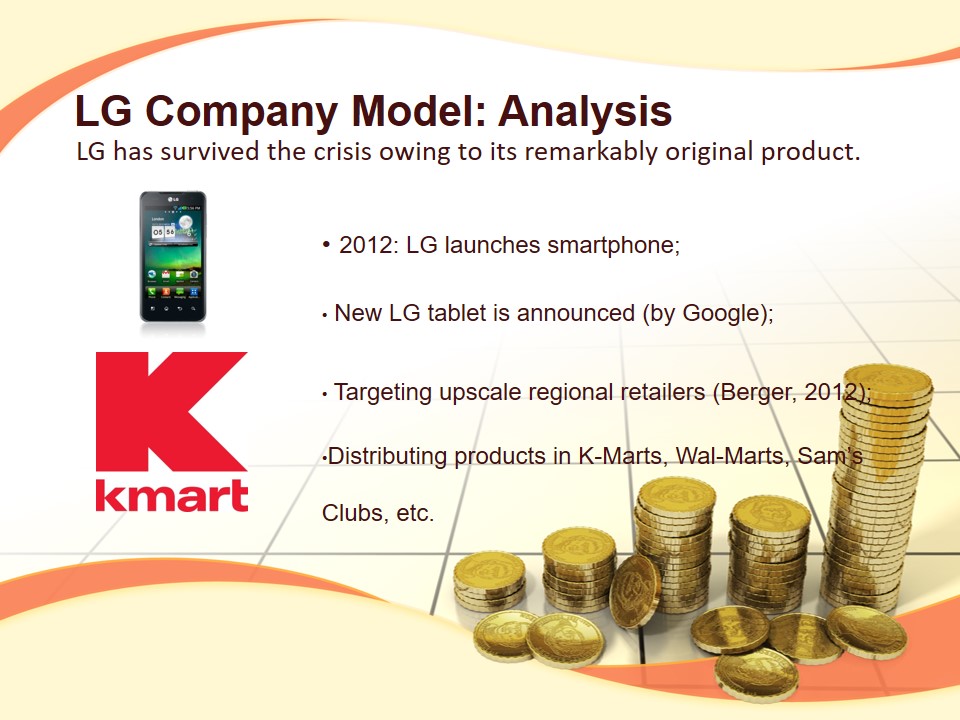
Motorola: Unethical Practices
Motorola’s partner uses child labor.
- HEG Electronics:
- In 2012, Motorola shakes a deal with HEG Electronics;
- Later, HEG Electronics is accused of using child labor;
- The percentage of student laborers amounts to 80% in HEG (China Labor Watch, 2012)
- Motorola response:
- Motorola claimed to have been unaware of the HRM policy adopted by HEG;
- Motorola does not seem to reject HEG Electronics’ further services despite the controversy around it.
Unfortunately, Motorola resorted to unethical practices in order to stay afloat during the crisis. To be more exact, the company engaged into business relationships with HEG, infamously known for its exploitation of child labor. Though Motorola claimed to have been unaware of the given fact, it still remains a major spot on the company’s reputation.
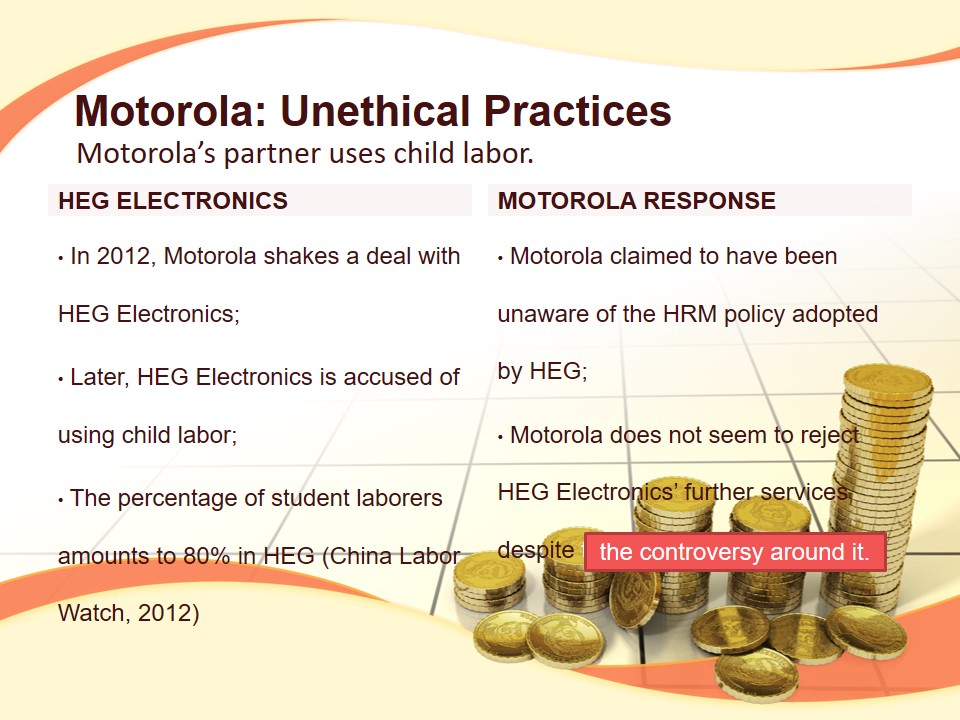
LG: Unethical Practices
LG has also been known for using HEG’s services.
- Same Old HEG:
- LG has been accused of collaborating with HEG, which uses child labor and provides unsanitary working conditions, as well;
- Despite the controversy, LG did not refuse HEG’s services;
- LG’s Anti-Competitive Practices:
- 2012: Samsung and LG team up to fix prices for appliances;
- The companies combine a KRW 44.64 billion to carry out anti-competitive practices (RepRisk, 2012).
Accused of collaborating with HEX as well, LG also has a number of unethical moves to confess about. First and foremost, the company tried to bring the rates of competitiveness down in an illegal way. Particularly, the company worked with Samsung to reduce prices for appliances.
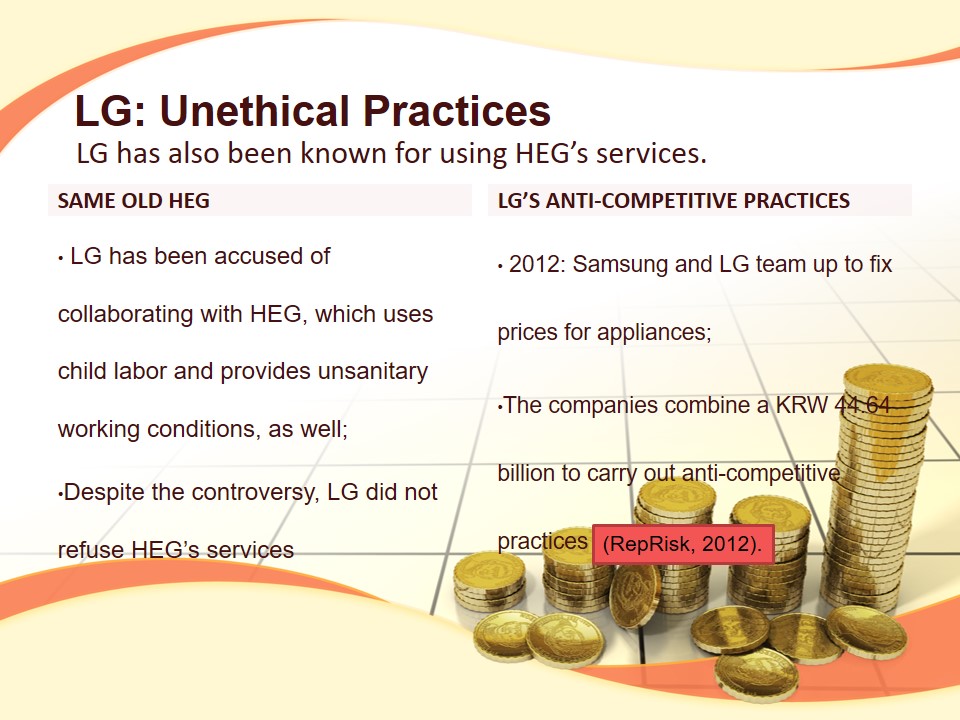
Motorola: Changes in Customer Demand Trend
Motorola has sold less units in 2012 than in 2011 and 2010 (Statista, 2012).
The company uses:
- cheap labor force;
- technological advances;
- flexible pricing policy to its advantage.
The old strategy still works, yet the rivals are obviously starting to take over.
Unfortunately, the strategy adopted by the company does not seem to work anymore.
Motorola has experienced considerable changes in customer demand (Shanahan, 2010). After selling 13,7 billion units in 2010, it increased the number of smartphones sold to 18.6 billion in 2011 and 23 billion in 2012, only to have them reduced by 1 billion in 2013. The company clearly needs to change its strategy of leveraging customer demand (Blackman, 2013).
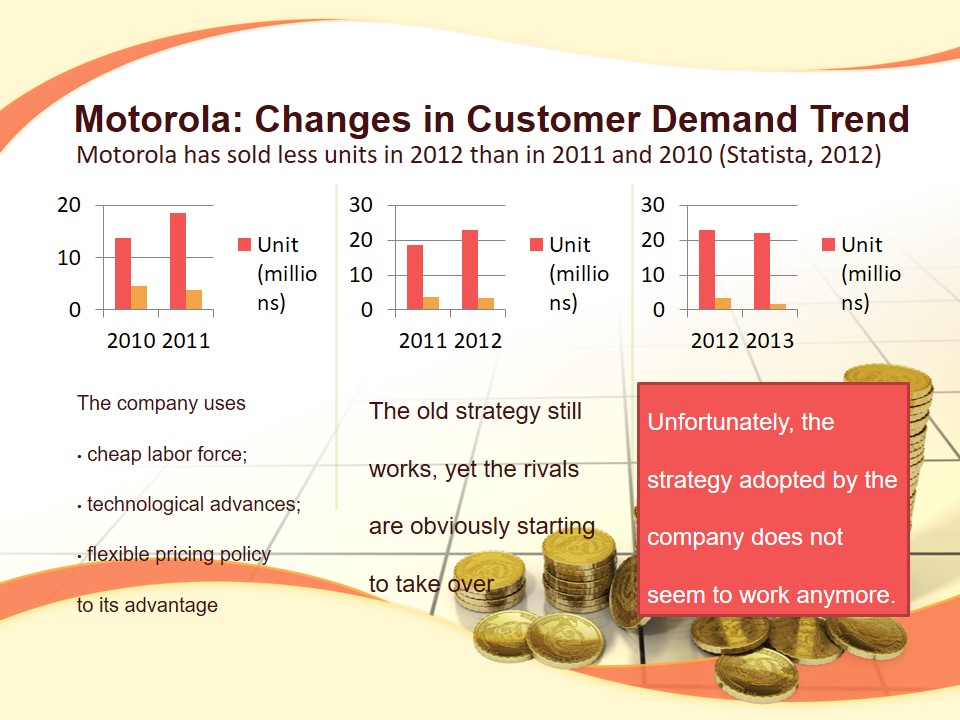
LG Electronics: Changes in Customer Demand Trend
A steep rise in the number of units sold could be observed in 2010-2011.
Despite the seeming efficacy of the new strategy, the company lost part of its TA.
Unlike Motorola, LG managed to retain its progress and maintain economic growth.
LG, in its turn, manages to maintain rather steady annual income, with 4.7, 9.3, 5.8 and 11.4 billion items sold in 2010, 2011, 2012 and 2013 correspondingly. It seems that LG’s independence from Google investments has affected its progress positively.
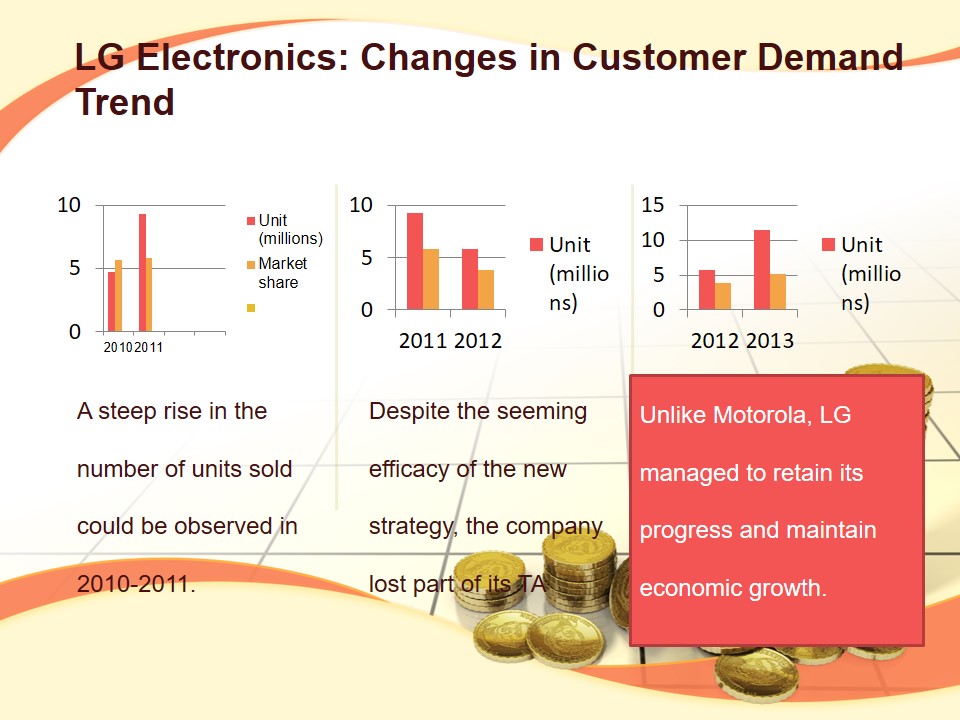
Leveraging Customer Demand: Response to Changes in Market Conditions
- Key specifics:
- Supply chain improvement;
- Instant visibility of the changes in the market conditions;
- Increase in speed of response to the change in the market conditions;
- Increase in the use of the company’s assets.
- Steps to Be Taken:
- Analyzing the customer demand on a daily (not weekly/monthly!) basis;
- Responding to the changes in the customer demand adequately;
- Shaping the production process in accordance with the demands.
As it has been stressed, leveraging customer demand is one of the key tasks for a tech company in the XXI century. Among the best strategies, response to changes in market conditions should be named (Keifer, 2010). It allows for a comparatively flexible customer policy and does not demand much money.
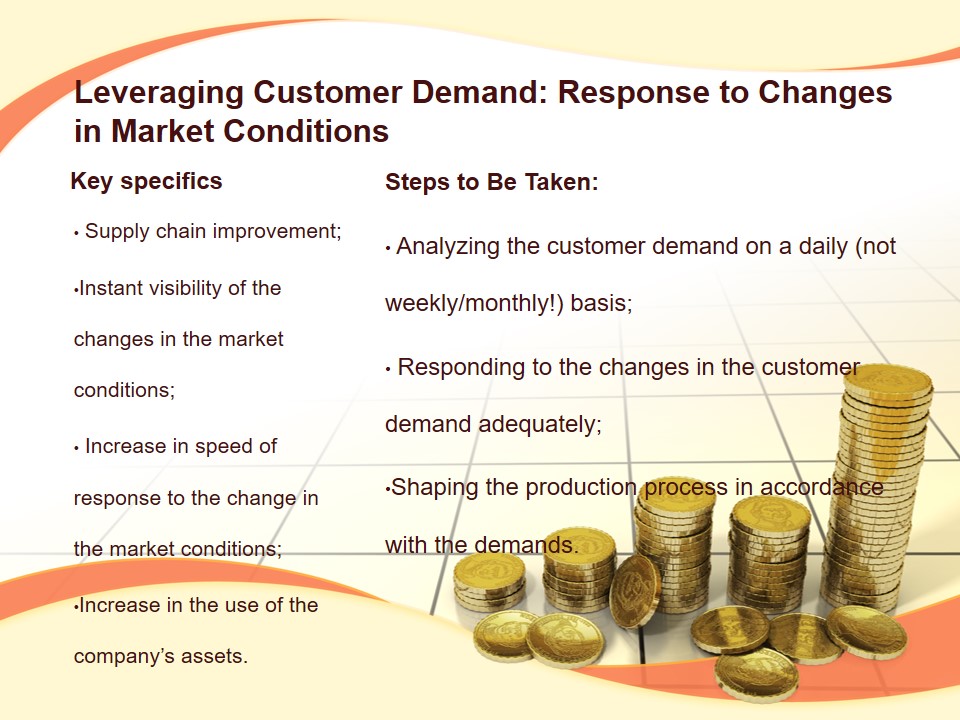
Leveraging Customer Demand: Vendor-Managed Inventory Relationships
- Key specifics:
- Customer demand visibility extension;
- Availability to observe customers’ inventory and demand patterns;
- Demand plan accuracy improvement;
- Inventory positions improvement;
- Replenishment policies improvement.
- Steps to Be Taken:
- Core supply chain process (CSCP) update;
- Vendor-managed inventory programs integration into the CSCP;
- Daily analysis of customers’ inventory and demand patterns;
- Switch from tied-up capital policies to free-up cash financial policies.
Vendor-managed inventory relationships, in their turn, are a much more complicated model (Blowon & Chulsoon, 2010). It presupposes that not only the core supply chain processes be updated, but also that they correlate with the vendor-managed inventory programs. The latter, in their turn, require that replenishment policies be upgraded.

Summary and Conclusions: Lessons to Learn
Motorola and LG provide a perfect example of using available resources to survive a crisis.
By establishing partnership with Google (Motorola) and introducing a brand new product (LG), the companies survived the 2012 Google crisis.
Although both Motorola and LG were involved in a major scandal regarding the HEX Company’s policies, the cooperation with HEX still helped them stay afloat during the 2012 Google crisis.
Despite the success of the strategies, they seem to have worn out their welcome, and both Motorola and LG need to search for other marketing solutions.
Response to Changes in Market Conditions and Vendor-Managed Inventory Relationships remain key strategies for leveraging customer demand in 2013.
Google crash in 2012 seemed to have been a major threat for the well-being of most companies. However, some enterprises managed to survive the crash. With their unique strategies, innovations and means of addressing customer demand, Motorola and LG not only withstood the challenges of the crisis, but also increased their efficiency.
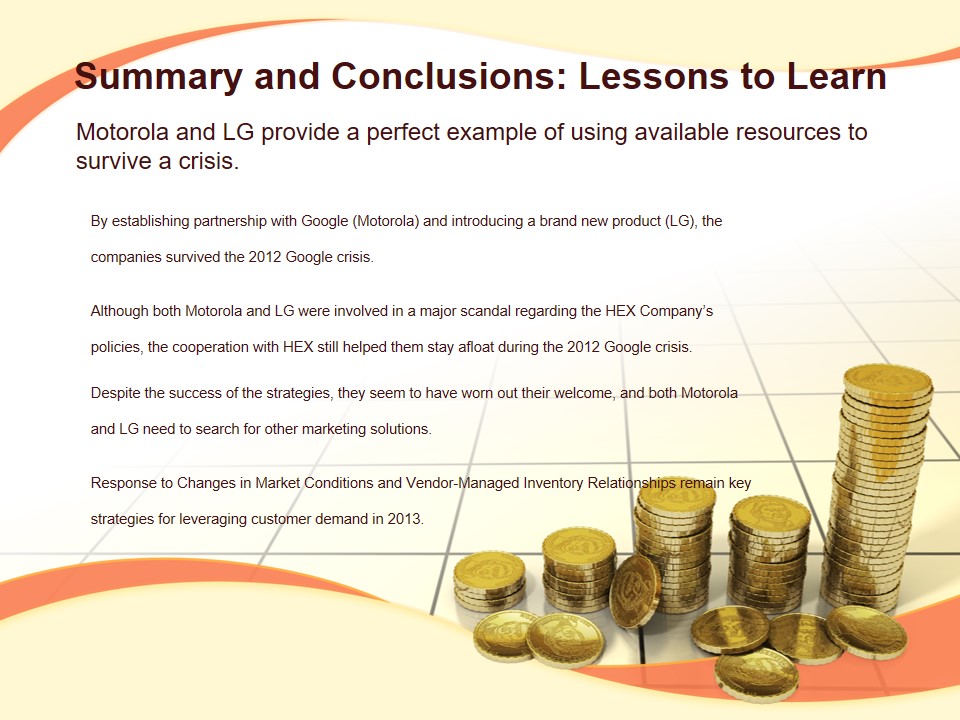
Reference List
Berger, J. T. (2012). LG’s brilliant marketing strategy. Web.
Blackman, I. D. (2013). Motorola’s global financial supply chain strategy. Supply Chain Management: An International Journal, 18(2), pp. 132–147.
Blowon, K. & Chulsoon, P. (2010). Coordinating decisions by supply chain partners in a vendor-managed inventory relationship. Journal of Manufacturing Systems, 29(2–3), 71–80.
China Labor Watch (2012). Samsung’s supplier factory exploiting child labor. Web.
Google loses $26 billion due to premature report (2012). Web.
Keifer, S. (2010). Beyond point of sale: Leveraging demand signals for forecasting. The Journal of Business Forecasting, 29(2), pp. 14–22.
RepRisk (2012). The most controversial companies of 2012. Web.
Shan, S. F. H., Nazir, T. & Zaman, K. (2013). Brand analysis of LG Electronics: A case study. Economics of Knowledge, 5(2), pp. 13–27.
Shanahan, M. (2010). Moving target: Understanding customer demand. International Journal of Operations & Production Management, 26(6), pp. 619–638.
Singh, H. (2012). Overnight Markets: Google share crash hits Wall Street. Web.
Statista (2012). Global market share held by Motorola in the mobile device market from 1st quarter 2008 to 4th quarter 2012. Web.
Womack, B. (2012). Google sales surge on Motorola Mobility, growth in ad clicks. Web.